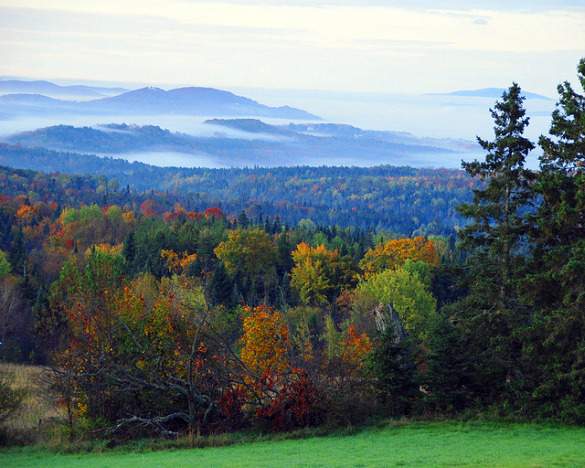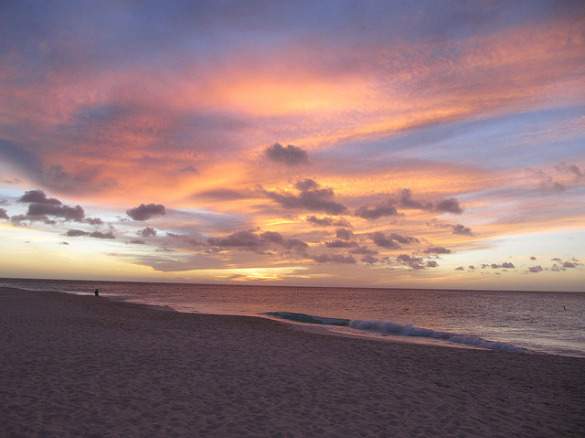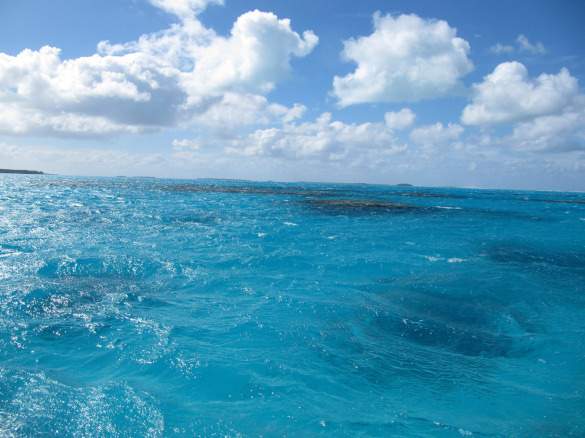Lots of long-term, RTW travelers plan their trips around shoulder seasons. It can save money when compared to traveling in high season, and the longer you’re on the road, the less you’ll want to deal with the crowds that come along with traveling in the most popular part of the year.
If you’re looking for itinerary ideas for your big trip, think about maximizing these popular shoulder seasons around the world.
New England
Mid-March through April & mid-October to mid-November

Why?
If you’re planning a big trip and want to add a leg in the United States, consider heading to the northeast. In the early spring you’ll find a little rain almost every day, but flowers are budding and city streets are more romantic than crowded. You’ll miss the May-June lilac season, but you can catch local flower shows in March. By mid-October, herds of rural foliage-seekers are starting to thin; the farther north you go, though, the more fall color remains.
Weather
For either shoulder season, bring a coat, pack an umbrella, a scarf and a pair of gloves, and be prepared to use them all. A sunny day in spring will average 55° F; in fall, 50°.
Where to go
Connecticut: Late Fall is a great time to visit the northwest’s Litchfield Hills; this southerly stretch of New England features preserved forests, lakes, ponds, and meadows, great antiquing, covered bridges, and even a piece of the Appalachian Trail. The warmest and most temperate slice of New England, it’s a great state for April garden visits; also in Litchfield, the White Flower Farm offers free walking tours.
Massachusetts: In both Fall and Spring, dine Colonial American style at Old Sturbridge Village or, when beaches are far less crowded with summer folk, attend April and November’s Taste of Cape Cod. Maddening crowds gather in Boston for two big shoulder season events: the Boston Marathon (third weekend in April) and the Head of the Charles Regatta (late October). The first won’t have much effect on hotel prices but the latter definitely will.
Rhode Island: Make a weekend of Newport‘s mansions: they’ll generally have weekend-only hours in March, and shorter hours in both April and November. You’ll miss the Newport Jazz Festival and Newport Arts Festival in August, but crowds will be far lighter and it’ll be a cinch to find room in a historic inn and 3 hours of free public parking.
New Hampshire: The shoulders just miss the harvest seasons, but in early Spring, maples are still making syrup; it’s a great time for a sugaring tour and pancake breakfast. The Keene Pumpkin Festival, a pre-Halloween tradition where 30,000+ jack o’lanterns are lit in the town square, is held in mid-October. During the Fall shoulder in northern, historic Portsmouth, you’ll just miss the early-October Seacoast Fringe Festival, but you’re bound to still see autumn leaves on the Colonial Seacoast Drive.
Maine: Temperatures don’t start climbing ’til May in this far northern state, but early Spring offers the best deals on cozy, historic B&Bs like the West End. By coming in Fall, you’ll miss the summer season for blueberries and Windjammer Cruises, but you could catch harvest festivals like Portland’s Harvest on the Harbor or the the eastern, Bar Harbor-adjacent Blue Hill Peninsula’s Foliage Food & Wine Festival. Nearby Acadia National Park, crowded in summer and early Fall, stays open all year.
The Caribbean
Mid-April to late May & early September to mid-December

Why?
During these times, hotel prices drop 15-30%, and you’ll generally find calm weather and empty beaches; however, be sure to consider the June-November hurricane season. Due to global warming, Category 5 storms like 2004’s Hurricane Ivan (which lay near-waste to Grenada and more) are projected to occur more frequently, and it’s important to plan your travel accordingly.
Weather and hurricane-avoidance rules of thumb
Mid-April – late May & early December: safe for all Caribbean islands and coasts
Early September – November: head south to drier islands and coasts
Where
Northern Caribbean
Bahamas: The island of Eleuthera offers small resorts (180° from the Disneyland of Atlantis) and a sense of history. Get to know the local culture through an Eleuthera Adventure Tour and enjoy a beautiful (and cheaper) beach at the boutique Pineapple Fields Hotel. Note that the Governor’s Harbour Homecoming Festival, traditionally held in late October or early November, can make it hard to find a room on the island.
Dominican Republic: Along the northern Samaná Peninsula, Cabarete Beach is laid-back during the day and aglow with little lanterns at night; early Spring in the area is cool, lush, and geared for adventure travel, but the Fall shoulder misses its Dominican Republic Jazz Festival by a couple of weeks.
Jamaica: Even during hurricane season, you’re safest exploring the high, cool elevations of the Blue Mountains, where you can stay at coffee plantations like the eco-friendly Lime Tree Farm. In October, you’ll find popular sportfishing tournaments near east coast Port Antonio and in west coast Savanna-la-Mar (around the 19th), a celebration of local reggae star Peter Tosh’s birthday.
Puerto Rico:Between April and May there are tons of local festivals across the country, but it’s quieter on Vieques, a tiny island off the east coast with small guesthouses like the Hector’s by the Sea and tours of a bioluminescent bay. Note: You can get to Vieques from the mainland by air or ferry, but there are drawbacks to both; flights can be costly and the ferry is often unreliable.
Read Finding the Independent Caribbean
Southern Caribbean
Aruba: On this Dutch-influenced island better known for gambling, gold jewelry, and high-rise chain hotels, the eco-friendly Bucuti Beach Resort (on powder-soft Eagle Beach) offers “green” tours of the island’s unique, arid landscape. Island crowds swell by Memorial Day Weekend, when the Soul Beach Music Festival comes to Oranjestad.
Barbados: Technically, this former British colony lies in the Atlantic, but the pale pink sands feel Caribbean. The west coast has the best diving and snorkeling, as well as most of the fancy resorts (like the Fairmont Royal Pavilion in St. James); because of the popular Barbados Reggae Festival in late April, the best Spring shoulder prices here are in May. The dramatic, rocky east coast is quieter and more pristine.
Trinidad & Tobago: Wealthy Trinidad has both rich oil deposits and wildlife sanctuaries (like Trinity Hills and Grafton Caledonia) full of indigenous plants and animals; in early November, Trinidad’s large Indian population rings in its new year with the festival of lights, Diwali. Sleepy Tobago is known for its beaches, rainforests and coral reefs; the Tobago Jazz Experience and International Game Fishing Tournament both take place in late April, so expect lower prices and more hotel availability in May.
Scandinavia
Late May to early June & the month of September
Why?
Sure, you’ll miss the summer festivals (and crowds) and the winter’s Northern Lights, but with Spring fields full of wildflowers, groves of autumn leaves, and temperatures that average 60° F, the regions’ shoulder seasons can hold their own for sheer beauty, and it’s always nice to save a few bucks in this notoriously expensive region. The earlier shoulder is actually high season for a glimpse of the midnight sun in northern Finland, Norway, or Sweden. September in Scandinavia is harvest season, ideal for scenic drives and picking mushrooms, berries, and more.
Denmark: The southernmost country in the region, temperatures here are always milder. In late May you’ll be just in time for the largest Carnival celebration in Northern Europe, held in far northwestern Aalborg; however, shoulder season doesn’t begin in this town until it’s over. Common Prayer Day in May (the fourth Friday after Easter) is a national holiday when most businesses will be closed. In either shoulder, plan a driving route along the marshy west coast of the Jutland region, full of historic seacoast inns like Ruth’s Hotel, built in 1904.
Finland: The last weekend in May, Helsinki hosts the World Village Festival, exhibiting cultures from around the world; hotel bargains will be hard to find in the city. Above the Arctic Circle, early June is your best bet to see the midnight sun more than once; in Lapland, you can stay in a unique glass-topped igloo at Hotel Kakslauttanen. In September, head to the forest of central Saarijärvi for an authentic Finnish sauna amidst autumn leaves at the Sumassaari Fitness Spa Hotel.
Norway: Come late May in the mountains, waterfalls are flowing and fruit trees are in bloom; it’s a great time to hike and stay in cabins along the way. A little pre-shoulder season coincides with National Day on May 17, when hotel rates drop across the country. The Bergen International Festival from late May to early June, which celebrates the performing arts community of the southwestern coastal city of Bergen (famed for its composers and musicians), can make it hard to find a room there. September is still warm in the outer part of the Oslofjörd; go island hopping by ferry and stay by the beach in Bygdøy.
Sweden: Stockholm doesn’t want you to feel unsatisfied: in early June, they host the Taste of Stockholm to celebrate their culinary scene, and in September, their Beer & Whisky Festival is a good place to learn how to drink at a professional level. Also in September, the Kivik Apple Market (in the inland southern town of Kivik) celebrates the end of the apple harvest. If you’re disappointed to miss the Northern Lights, stay in the über-cool Nordic Light Hotel, which features an unearthly glow in each room.
Note: Icelandair, which offers some of the best routes to Scandinavia, offers great deals during these shoulder seasons.
Read Planning a Trip to Scandinavia
East Africa
Mid-May to mid-June & mid-September to mid-October

Why?
In the earlier shoulder in East Africa, the spring high season is over but the weather is still cool and dry. Animals are gathering at waterholes, making game viewing easy. In the early Fall, safari crowds have started to head home, but the tail end of the Great Migration is often still heading across Kenya’s Masaai Mara towards Tanzania.
Throughout the whole region, October, the start of the intermittent or “short” rain season, is best for bird-watching. Only a tiny handful of tour companies offer safaris all across East Africa.
Note: On Kenya and Tanzania’s coasts, high season begins in September; visit them in the earlier shoulder for better deals.
Where
Kenya: On June 1, much of the country takes a holiday on Madaraka Day to celebrate its independence from Britain. With eight major lakes, wide plains like the Tsavo and Amboseli, a 536 km/333-mile coastline, several forest reserves, deserts, mountains, volcano craters, and the cities of Mombasa and Nairobi, you could easily spend weeks touring Kenya. If your goal is to see as much of East Africa as possible, stay in the south, where the Serengeti, Tsavo, Amboseli, and Mount Kilimanjaro border Tanzania and/or Lake Victoria, which lies in Kenya, Tanzania, and Uganda. If your flights dictate an overnight or two in Nairobi, try the Macushla House, home to monkeys and down the street from a giraffe park.
Tanzania: If you’re looking for a once-in-a-lifetime safari, the Serengeti’s official site (under “Safari”) lists an array of luxurious camps that skirt Ngorongoro Crater, follow the Great Migration, border Lake Manyara (famous for its tree lions) and more. Most of these camps are booked through third-party safari companies, which will all provide lists of what to pack.
Read Climbing Africa’s Highest Peak: Mount Kilimanjaro
Rwanda: See the country’s famed (and highly endangered) gorillas and one of the world’s largest concentrations of primates in Nyungwe National Park, and be sure to visit the Genocide Memorial Centre in Kigali City. September 25 is Kamarampaka Day, a bank holiday celebrating the country’s independence from British rule.
South Pacific
May & early to mid-November

Why?
In this blue, warm, humid stretch of paradise, the temperature averages 75°F all year long. However, late November to April is the rainy/cyclone season, and the summer months are chock full of French, British and Aussie tourists. Before and after, the water is clear for snorkeling and diving — and far less likely to be full of cruise ships.
Where
Cook Islands: There are 15 islands in this culturally Polynesian chain, covering 2 million square miles of ocean; the two most-visited islands are Rarotonga, bisected by a jungly mountain spine, and quieter Aitutaki, which still evokes Hawaii in the 1950s. While no longer a Kiwi territory, the Cooks’ continued use of New Zealand currency makes it cheaper than French Polynesia for similar sand, water, and palm trees. You’ll miss the canoe festival of Vaka Eiva in late November, but you might catch the Te Mire Ura dancing contest in late May or, on November 1, the Turama festival to honor the dead.
- Look for hostels in the Cook Islands
Fiji: Comprised of 333 islands, you might need a few shoulder seasons to see the whole country. In either shoulder, take a small-ship whale watching cruise and go diving with humpbacks. Or, stay on the white-sand beaches of the Coral Coast in Viti Levu, where the Kula Eco Park offers a microcosm of Fiji’s indigenous flora and fauna. Note: the patriotic Ratu Sakuna Day has been discontinued as a late May bank holiday.
Tahiti: By not coming during the high June-August season, you’ll miss both the uniquely Polynesian Heiva Nui festival and the French summer vacationers. However, in mid-May you could see the Tahiti Pearl Regatta, or in the first half of November, the outrigger canoe races of Hawaiki Nui Va’a and amazing Polynesian body art of Tattoonesia. To avoid crowds altogether, escape to private Vahine Island in the Tahaa lagoon — and consider never returning to your real life.
Tips for booking travel during shoulder season
- Most shoulder seasons are between Easter and Thanksgiving and on either side of school vacations, but there are exceptions. Always check for local holidays and festivals, as these can create high season pockets within a shoulder.
- If you book your flights half-in, half-out of a shoulder season, you’ll pay high season prices.
- Stick as close as possible to a high season for the best weather. While global warming has changed weather patterns around the globe, low seasons still generally involve heat and humidity, storms or freezing cold, while shoulder seasons will offer milder temperatures and precipitation.
- That said, pack for a little rain, cold or sweltering, and make note of things to do indoors – weather is the biggest risk when it comes to shoulder season travel.
- If you’re excited about an attraction, be sure to check its operating dates and times. Even before a low season officially begins, some tourist attractions pare back their hours or even close.
Sample RTW trip utilizing shoulder season
Read more about saving on your travels:
- The Stopover Secret: How to Get More From Your Flights
- 5 Ways to Score Luxury Travel Deals
- How to Make the Most of Your Summer Travel Budget
- 10 Free Ways to Discover Your World
- 8 Ways to Travel for Free on Your RTW Trip
- How to Travel Around the World on $40 Per Day
Photos by: Maggie-Me, travelswithtwo, Froskeland, wwarby, Christian Haugen

